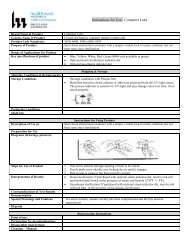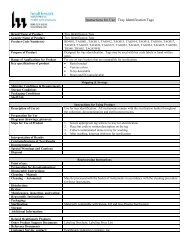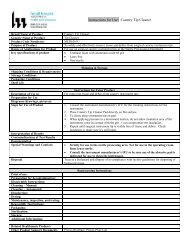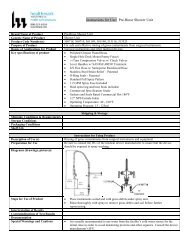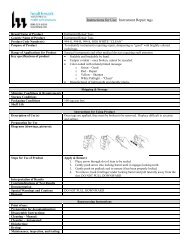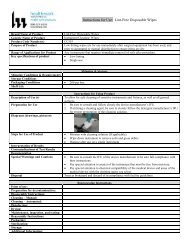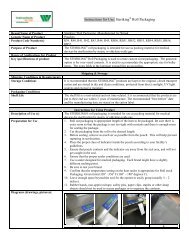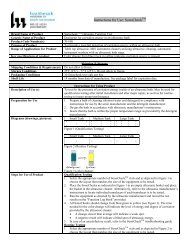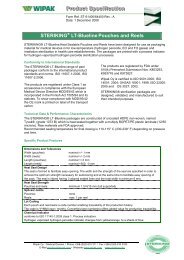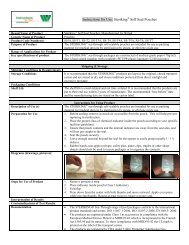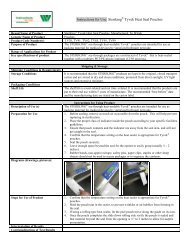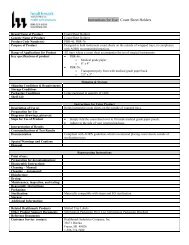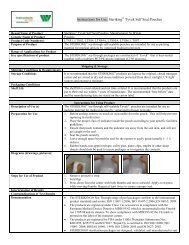suggested policy for the monitoring of the cleaning ... - Support
suggested policy for the monitoring of the cleaning ... - Support
suggested policy for the monitoring of the cleaning ... - Support
Create successful ePaper yourself
Turn your PDF publications into a flip-book with our unique Google optimized e-Paper software.
SUGGESTED POLICY FORTHE MONITORING OF THE CLEANING EFFICIENCY OFAN ULTRASONIC CLEANERS( SONIC & TOSI) WEEKLYSUBJECT: ULTRASONIC CLEANER MONITORING WEEKLYDEPARTMENT: Central ServiceAPPROVED BY:EFFECTIVE:REVISED: 3/2012PURPOSE:To monitor <strong>the</strong> ULTRASONIC CLEANING process and to ensure proper<strong>cleaning</strong> and reduce risk to personnel or patients.(1,10,13,14)POLICY:SonoCheck kit is designed to monitor <strong>the</strong> <strong>cleaning</strong> function <strong>of</strong> an ULTRASONICCLEANER. To ensure that <strong>the</strong> ultrasonic process is <strong>cleaning</strong> properly, a soniccheck test kit should be used to monitor <strong>the</strong> occurrence <strong>of</strong> <strong>cleaning</strong> instruments.The sonic test kit is to be used according to <strong>the</strong> manufacture's guidelines toensure that <strong>the</strong> <strong>cleaning</strong> process is occurring and <strong>the</strong> ultrasonic cleaner isfunctioning properly. (1,6,7,8,9,1013,14)RATIONALE :ST 79; 2009A section 7.5.3.3 states this on weekly testing “…Mechanical<strong>cleaning</strong> equipment should be tested upon installation, weekly (preferablydaily) during routine use, and after major repairs. A major repair is a repairthat is outside <strong>the</strong> scope <strong>of</strong> routine preventive maintenance and thatsignificantly affects <strong>the</strong> per<strong>for</strong>mance <strong>of</strong> <strong>the</strong> equipment. Examples includereplacement <strong>of</strong> <strong>the</strong> water pump(s), detergent delivery system, heatingsystem, water delivery system, water treatment system, or computercontrol or an upgrade to s<strong>of</strong>tware…”Sonic cleaners are consideredmechanical <strong>cleaning</strong> equipment by AAMI."Cleaning, not sterilization (or disinfection) is <strong>the</strong> first and most important step inany instrument processing protocol. Without first subjecting <strong>the</strong> instrument to athorough, validated and standardized (and ideally automated) <strong>cleaning</strong> process,
<strong>the</strong> likelihood that any disinfection or sterilization process will be effective issignificantly reduced". (11)The ultrasonic <strong>cleaning</strong> process cleans dirty surgical instruments so <strong>the</strong>y can behandled safely, repackaged, and sterilized <strong>for</strong> a future surgery. The danger <strong>of</strong>handling instruments contaminated with blood is obvious in this age <strong>of</strong> hepatitis,CJD and HIV. The procedures <strong>for</strong> sterilizing instruments are based on years <strong>of</strong>scientific testing <strong>of</strong> <strong>cleaning</strong> instruments. If surgical instruments are not clean,<strong>the</strong> procedures are ineffective. Dried blood on instruments is hazardous to <strong>the</strong>employees <strong>of</strong> <strong>the</strong> hospital and to <strong>the</strong> next surgical patient upon which <strong>the</strong>instruments are used. (1,2,3,4,8,)An ultrasonic cleaner enables thorough <strong>cleaning</strong> <strong>of</strong> equipment by ultrasonicagitation that dislodges soil from instruments.Ultrasonic cleaners do not disinfect instruments. They are used to assist with <strong>the</strong><strong>cleaning</strong> <strong>of</strong> instruments that cannot be adequately cleaned manually such asspiral wound instruments like biopsy <strong>for</strong>ceps.Ultrasonic vibration at <strong>the</strong> frequency used <strong>for</strong> <strong>cleaning</strong> does not killmicroorganisms and infective aerosols may be produced. It is <strong>for</strong> this reason that<strong>the</strong> lid <strong>of</strong> <strong>the</strong> tank must be tightly closed during operation.Ultrasonic cleaners work by subjecting instruments to high frequency, highenergysound waves. This causes <strong>the</strong> soil to be dislodged from instruments anddrop to <strong>the</strong> bottom <strong>of</strong> <strong>the</strong> tank, or be sufficiently loosened that it will be removedduring <strong>the</strong> rinsing process.The detergent used in <strong>the</strong> ultrasonic tank must be carefully selected inaccordance with advice from <strong>the</strong> tank's manufacturer. Optimally it will be aneutral, low-foaming product and enzymatic cleaners will have enhanced benefitsin this process.Degassing <strong>of</strong> <strong>cleaning</strong> solutions is extremely important in achievingsatisfactory <strong>cleaning</strong> results. Fresh solutions or solutions which havecooled must be degassed be<strong>for</strong>e proceeding with <strong>cleaning</strong>. Degassingis done after <strong>the</strong> chemical is added and is accomplished by operating<strong>the</strong> ultrasonic energy and raising <strong>the</strong> solution temperature. The timerequired <strong>for</strong> degassing varies considerably, based on tank capacity andsolution temperature, and may range from several minutes <strong>for</strong> a smalltank to an hour or more <strong>for</strong> a large tank. An unheated tank mayrequire several hours to degas. Degassing is complete when smallbubbles <strong>of</strong> gas cannot be seen rising to <strong>the</strong> surface <strong>of</strong> <strong>the</strong> liquid and apattern <strong>of</strong> ripples can be seen.
Routine <strong>cleaning</strong>Cleaning <strong>the</strong> ultrasonic cleaner and replacement <strong>of</strong> <strong>the</strong> <strong>cleaning</strong> solution isnecessary at least daily or more frequently if solution soiled.Per<strong>for</strong>mance testingThe efficacy <strong>of</strong> <strong>the</strong> ultrasonic cleaner should be tested at a minimum weekly anddaily if possible. The results <strong>of</strong> <strong>the</strong> testing shall be documented as part <strong>of</strong> <strong>the</strong>pro<strong>of</strong> <strong>of</strong> process.Sonic cleaners fail <strong>for</strong> many reasons. Tests should provide a means <strong>of</strong><strong>monitoring</strong> <strong>the</strong> variables that influence <strong>the</strong> effectiveness <strong>of</strong> <strong>the</strong> ultrasonic <strong>cleaning</strong>process. Some <strong>of</strong> <strong>the</strong>se variables are water, time, detergent, enzyme,temperature, high pH, agitation, speed, tray selection, initial heat, drying,obstructions, and insufficient amount <strong>of</strong> chemicals and equipment faliure. (7)Proper <strong>cleaning</strong> is critical. The SonoCheck test kit provides an independentobjective test <strong>of</strong> clean and allows <strong>the</strong> Sterile Processing pr<strong>of</strong>essional to monitorand ensure proper <strong>cleaning</strong> in <strong>the</strong> sonic process.(1)AAMI does list a sonic cleaner as a piece <strong>of</strong> medical equipment in section7.5.3.3; <strong>the</strong>re are o<strong>the</strong>r references that support <strong>the</strong> minimum <strong>of</strong> weekly testing <strong>of</strong>all type <strong>of</strong> sonic equipment with or without “retro flow pulse adapter”.Section 10.2 and ANNEX D states“…Health care personnel may per<strong>for</strong>mverification tests as part <strong>of</strong> <strong>the</strong> overall quality assurance program. Thisverification may include <strong>the</strong> use <strong>of</strong> test devices that monitor <strong>the</strong> functionality <strong>of</strong><strong>the</strong> <strong>cleaning</strong> equipment in <strong>cleaning</strong> surfaces and that ensure adequate fluid flowin equipment that has adaptors <strong>for</strong> lumened devices…”Section 7.5.3.3 states“…Mechanical <strong>cleaning</strong> equipment should be tested uponinstallation, weekly (preferably daily) during routine use, and after major repairs.A major repair is a repair that is outside <strong>the</strong> scope <strong>of</strong> routine preventivemaintenance and that significantly affects <strong>the</strong> per<strong>for</strong>mance <strong>of</strong> <strong>the</strong> equipment.Examples include replacement <strong>of</strong> <strong>the</strong> water pump(s), detergent delivery system,heating system, water delivery system, water treatment system, or computercontrol or an upgrade to s<strong>of</strong>tware..”The 2011 AORN RP <strong>for</strong> Cleaning and Care <strong>of</strong> Surgical Instruments and PoweredEquipment Recommendation XXII –Quality section is now supporting <strong>the</strong> testing<strong>of</strong> mechanical instrument washers be<strong>for</strong>e initial use, weekly during service, andafter major maintenance.JCAHO in standard E.C.6.20 it states that medical equipment is maintained,tested and inspected
So in accordance with ANSI/AAMI ST79-2009; ANSI/AAMI TIR12-2005; JCAHOEC6.20-2005, and AORN, Healthmark recommends at least weekly <strong>monitoring</strong><strong>of</strong> <strong>the</strong> <strong>cleaning</strong> efficacy <strong>of</strong> any sonic <strong>cleaning</strong> unit with <strong>the</strong> following verificationtests:• Verification <strong>of</strong> sufficient cavitation energy with <strong>the</strong> Sonocheck<strong>monitoring</strong> vials*. Designed to change color (blue to yellow) when <strong>the</strong>ultrasonic cleaner is supplying sufficient energy and conditions are correct(degassed water, temperature, etc.) <strong>the</strong> Sonocheck is an easy to useand interpret method <strong>for</strong> <strong>monitoring</strong> cavitation energy. Failure to changecolor indicates that ei<strong>the</strong>r <strong>the</strong> sonic bath conditions were not correct, or afailure <strong>of</strong> one or more <strong>of</strong> <strong>the</strong> ultrasonic transducers.• You must remember that we test <strong>the</strong> sonic <strong>for</strong> caviation and that <strong>the</strong>re isnot a one-to-one correlation between cavitation activity and <strong>cleaning</strong>effectiveness that is why you also run <strong>the</strong> TOSI inside a sonic toge<strong>the</strong>rwith a Sonocheck. You show both caviation and <strong>cleaning</strong> ability. Youmust pass <strong>the</strong> Sonocheck and clean a TOSI at <strong>the</strong> same time. Justturning yellow is not enough and just passing <strong>the</strong> TOSI by itself is notenough. You need to have enough "sonic power - caviation" to clean asurgical instrument.Please note as with any sonic <strong>cleaning</strong> process rinsing is very important. If <strong>the</strong>sonic cleaner does not have a rinse cycle <strong>the</strong> TOSI must be rinsed <strong>of</strong>f (like youwould your instruments). This is important because you want to make sure you ifany organic soil was re-deposited back onto <strong>the</strong> coupon it is washed <strong>of</strong>f ( justlike an instrument).JCAHO and AAMI both recommend that Sterile Processing department haveprocess per<strong>for</strong>mance in place (1,5). Using <strong>the</strong> SonoCheck and TOSI accordingto <strong>the</strong> manufacture's guidelines helps ensure adherence to both JCAHO andAAMI standards and having a properly functioning <strong>cleaning</strong> process.PROCEDURE:"A problem analysis should be completed <strong>for</strong> any problem with any aspect<strong>of</strong> decontamination that can pose a risk to personnel or patients. Theproblem analysis should define and resolve <strong>the</strong> problem and <strong>the</strong> systemshould be monitored to ensure that <strong>the</strong> problem has been corrected"(1)Directions <strong>for</strong> useSafety lidIndicator solutionNuclei <strong>for</strong> cavitation
Daily Inspection & Testing• Follow manufacture guidelines concerning <strong>the</strong> daily inspection <strong>of</strong> equipment(screens…)• Inspect <strong>the</strong> level <strong>of</strong> <strong>the</strong> detergent daily (mark <strong>the</strong> container <strong>of</strong> <strong>the</strong> solutiondaily with <strong>the</strong> date at <strong>the</strong> level <strong>of</strong> <strong>the</strong> solution in <strong>the</strong> container) this will allow avisual inspection if <strong>the</strong> solution is actual being used• Log all observations in a report as daily observations• Report any concerns to <strong>the</strong> proper management staff within <strong>the</strong> departmentto addressTypes <strong>of</strong> Testing <strong>of</strong> <strong>the</strong> Sonic CleanerThe functional test will check <strong>the</strong> uni<strong>for</strong>m operation <strong>of</strong> <strong>the</strong> empty ultrasoniccleaner’s tank. This testing should be done on installation <strong>of</strong> <strong>the</strong> equipment andor after major repairs. The diagram below gives <strong>the</strong> <strong>suggested</strong> placement <strong>of</strong>SonoChecks in relation to <strong>the</strong> sonic tank size.Remember that degassing should always be done be<strong>for</strong>e any testing cyclebegins.Record all results <strong>for</strong> trend analysis and <strong>for</strong> help in any troubleshooting issues.x xxx x Small up to 5 ltrs or (1.5 gals)x x xx x xMedium size tank5 to 20 ltrs or (1.6- 5 gals)x x xx x x xx x x xLarge above 20 ltrs or greater than 5 gals.x x x x
Routine Testing <strong>of</strong> <strong>the</strong> Sonic CleanerThe routine test will also monitor <strong>the</strong> per<strong>for</strong>mance <strong>of</strong> <strong>the</strong> sonic cleaner. Theroutine test is per<strong>for</strong>med under normal conditions in an empty tank that has beendegassed. Frequency <strong>of</strong> testing should be at least weekly but preferably daily.The diagram below gives <strong>the</strong> <strong>suggested</strong> placement <strong>of</strong> SonoChecks in relation to<strong>the</strong> sonic tank size <strong>for</strong> routine testing. All testing results should be logged andsaved <strong>for</strong> trend analysis and troubleshooting concerns.xSmall up to 5 litres or (1.5 gals)xxMedium size tank 5 to 20 liters or (1.6- 5 gals)x x xLarge above 20 liters or greater than 5 gals.Sonic & Blood Soil Test• Make sure that <strong>the</strong> ultrasonic cleaner has been degassed prior torunning <strong>the</strong> test and has <strong>the</strong> correct amount <strong>of</strong> <strong>cleaning</strong> solution in<strong>the</strong> tank/bath.• The number <strong>of</strong> Sonochecks placed in <strong>the</strong> tank will be dependent on<strong>the</strong> volume <strong>of</strong> <strong>the</strong> tanks (see routine testing).• Place <strong>the</strong> correct amount <strong>of</strong> SonoChecks in <strong>the</strong> appropriate stray<strong>for</strong> testing according to tank size• Secure one (1) TOSI to <strong>the</strong> middle <strong>of</strong> <strong>the</strong> tray• TOSI and SonoCheck can be placed in <strong>the</strong> same tray• Run <strong>the</strong> Sonic through its normal cycle ( record <strong>the</strong> cycle )• Record both <strong>the</strong> SonoCheck and TOSI results at <strong>the</strong> end <strong>of</strong> <strong>the</strong>cycle
• A Color change from blue/green to yellow is a pass <strong>for</strong> <strong>the</strong>SonoCheck• A passing <strong>for</strong> a TOSI is a 0• In case <strong>of</strong> unsatisfactory results, please refer to <strong>the</strong> troubleshootingguide• Record all in<strong>for</strong>mation in log book**Please note as with any sonic <strong>cleaning</strong> process rinsing is very important.If <strong>the</strong> sonic cleaner does not have a rinse cycle <strong>the</strong> TOSI must be rinsed <strong>of</strong>f(like you would your instruments). This is important because you want tomake sure you if any organic soil was re-deposited back onto <strong>the</strong> coupon itis washed <strong>of</strong>f ( just like an instrument).Maintenance on Equipment(6,10):• After any maintenance on <strong>the</strong> equipment, per<strong>for</strong>m a test using <strong>the</strong>SonoCheck Test Kit to ensure that <strong>the</strong> equipment is <strong>cleaning</strong> properly.• Follow <strong>the</strong> weekly test process.• Have <strong>the</strong> maintenance person wait until <strong>the</strong> test results are completeRESPONSIBILITY:Central Service personnel are responsible <strong>for</strong> <strong>the</strong> proper use, resultinterpretation, and documentation <strong>of</strong> <strong>the</strong> Sonic Test Kit when used on an soniccleaner.(1,5,16)In-service and training <strong>of</strong> <strong>the</strong> staff should be done at least yearly on <strong>the</strong>equipment (sonic) and <strong>the</strong> use <strong>of</strong> <strong>the</strong> sonic test kit.
Equipment name _______________ Equipment Serial # _____________Detergent type ____________________________Date TestRun1/1/2010TestersInitialsSonocheckResultTOSIResultCyclelengthCommentAction ifneededSMK Yellow 0 6 minutes noneTOSI results are from 0 to 5SonoCheck record <strong>the</strong> color change from a blue/green to a yellow
SonoCheck trouble-shooting guideIf <strong>the</strong> SonoCheck ultrasonic cavitation monitor does not change color or if <strong>the</strong>time required generating <strong>the</strong> color change takes longer than normal, pleasecheck <strong>the</strong> following guide:Problem Reason Corrective actionDe-gassing Dissolved gasses will absorbultrasonic energyDe-gas solution accordingto equipment manualWater level Ultrasonic energy may reflect<strong>of</strong>f <strong>of</strong> <strong>the</strong> surface <strong>of</strong> <strong>the</strong>solution and change energydistributionCheck equipment manual<strong>for</strong> correct water levelOperatingcycle timeInstrumentloadTransducerfailureLow energyTray selectionTime varies with <strong>the</strong> amount<strong>of</strong> ultrasonic energy availableHeavy instrument loading andcertain materials can absorbultrasonic energyTransducer efficiency maydecrease with age. Individualtransducers may fail whileo<strong>the</strong>rs in <strong>the</strong> equipmentcontinue to functionTransducer inefficiency or <strong>the</strong>ultrasonic basket may absorbtoo much energyVaries trays (<strong>the</strong> material <strong>the</strong>yare made out <strong>of</strong>) absorb andinhibit <strong>the</strong> transfer <strong>of</strong> sonicenergy within <strong>the</strong> sonic tank.They can change <strong>the</strong> energydistribution.Longer operating cyclesgenerally provide betterresultsLook <strong>for</strong> weak points using<strong>the</strong> functional test andcheck <strong>for</strong> ultrasonicabsorbent material likesilicone or plasticsPer<strong>for</strong>m functional test,placing Sonocheckmonitors in eachtransducer location (seeequipment manual)Check per<strong>for</strong>mancewithout basket in place.Compare per<strong>for</strong>manceagainst ano<strong>the</strong>r ultrasoniccleaner if available. Call<strong>for</strong> serviceTest with a different tray(change types <strong>of</strong> tray).Use a tray that does notabsorb or inhibit <strong>the</strong>transfer <strong>of</strong> sonic energy.
REFERENCES:1. ANSI/AAMI-ST 79;20062. Blood as a Soil on Surgical Instruments; Cleaning Pr<strong>of</strong>ile, Cleaning,Detection; M.Pfeifer, Zentr Steril 1998;6 (6);381-3853. Standardized Test Soil Blood 1: Composition, Preparation, Application;M.Pfeifer, Zentr Steril 1998;6 (6);304-3104. OSAKA REPORT; Importance <strong>of</strong> <strong>the</strong> <strong>cleaning</strong> test; University <strong>of</strong> Osaka,Department <strong>of</strong> Medicine, Ryo Fushimi, 20005. www.jcaho.org6. http://www.pro<strong>for</strong>mance-test.com/WallChart/WallChart.html7. http://www.pro<strong>for</strong>mance-test.com/<strong>Support</strong>Material/TechnicalBulletin1.html8. http://www.pro<strong>for</strong>mancetest.com/<strong>Support</strong>Material/BloodAsASoilonSurgicalInstruments.htm9. http://www.pro<strong>for</strong>mancetest.com/<strong>Support</strong>Material/StandardisedTestSoilBlood1.htm10. http://www.pro<strong>for</strong>mance-test.com/index.html11. 510(k) Summary and Overview; Safety, Efficacy and MicrobiologicalConsiderations,. The System 83 plus Washer -Disinfector; CustomUltrasonics, Inc,1998, page 7.12. www.aorn.org13. http://www.healthmark.info/MktingPieces/ProductBrochures/2006/Pro<strong>for</strong>manceJournal.pdf14. The Cleaning Process – Authors Ralph Basile / Steve Kovach – ManagingInfection Control/July 2003, pages 66-68.15. Validation <strong>of</strong> SonoCheck <strong>for</strong> <strong>the</strong> Monitoring <strong>of</strong> Ultrasonic Energy <strong>of</strong> UltrasonicCleaners – ZentrSteril – Volume 10 – 2002- Martin Pfeifer16. www.aorn.org



